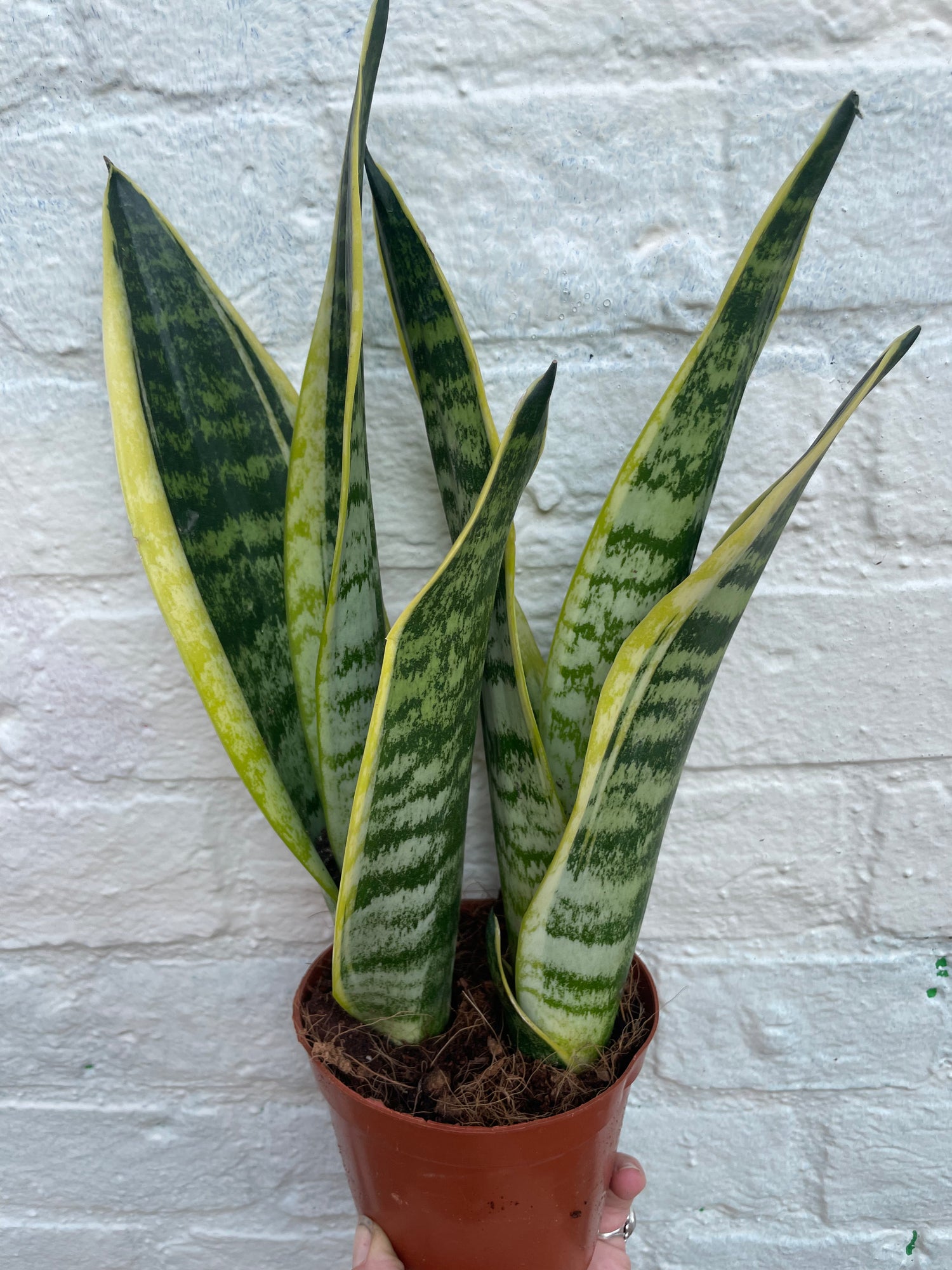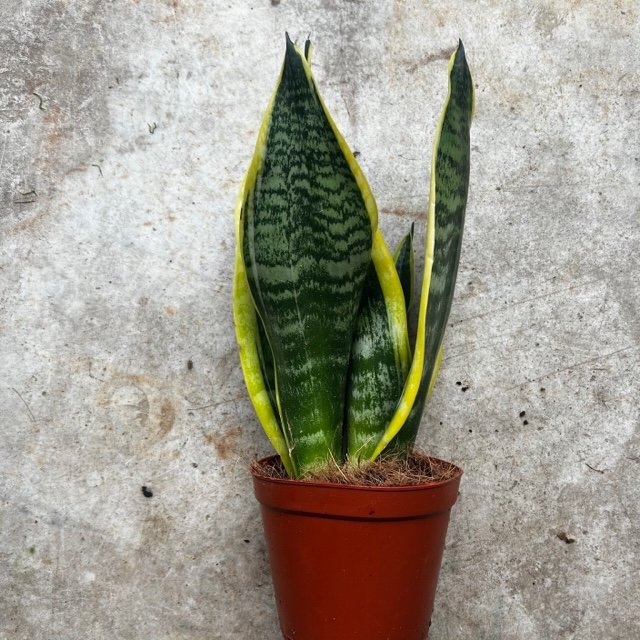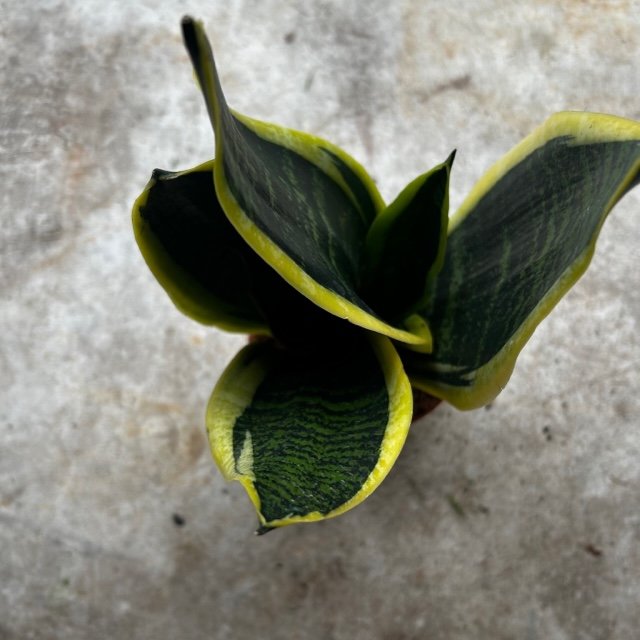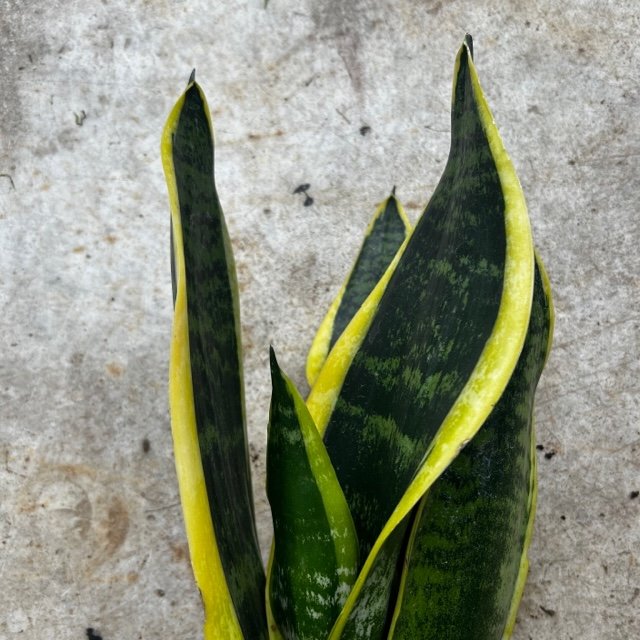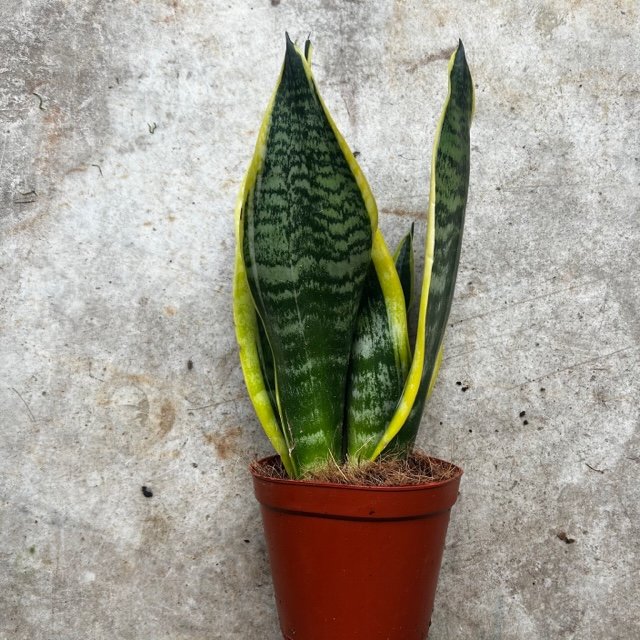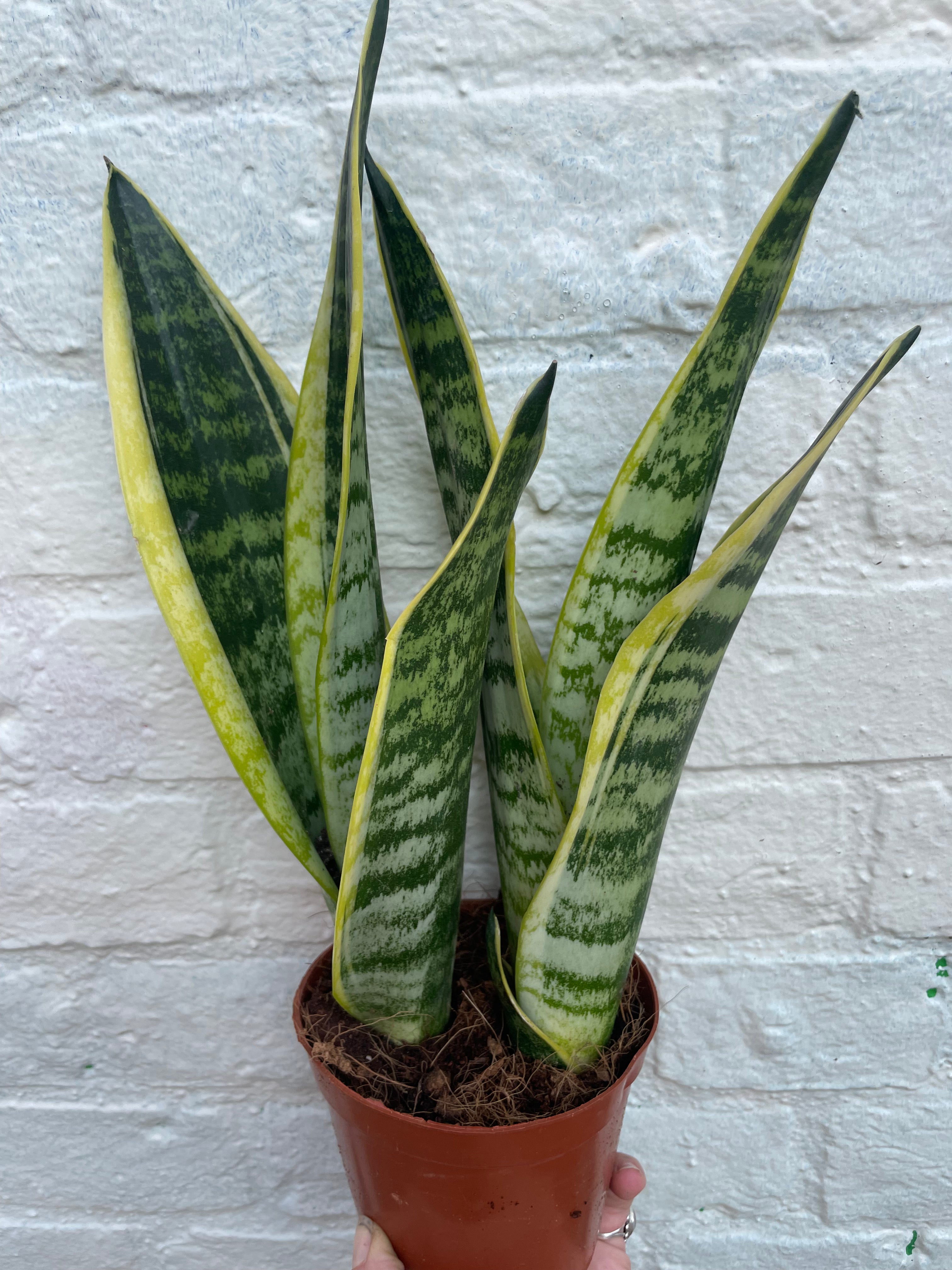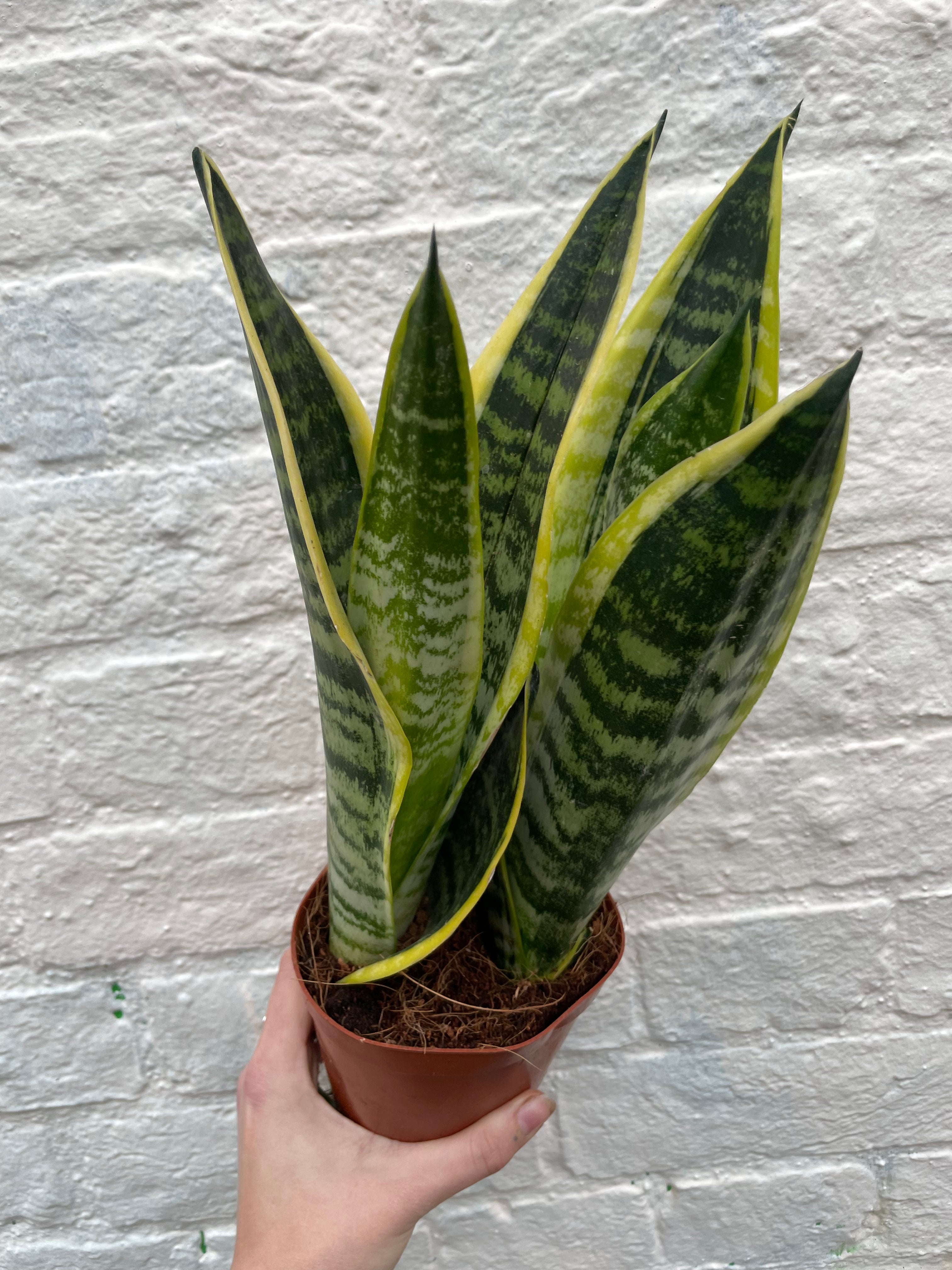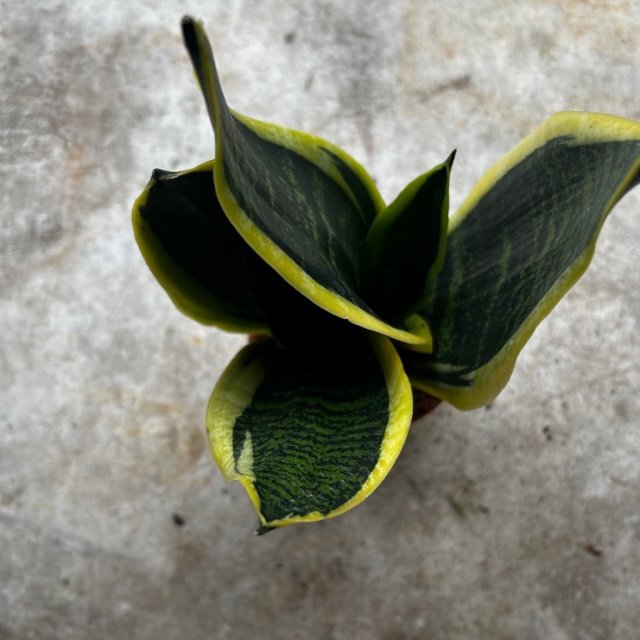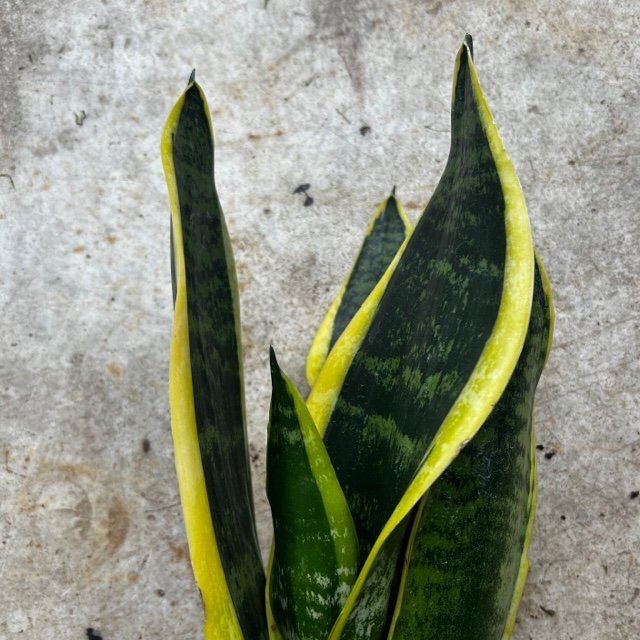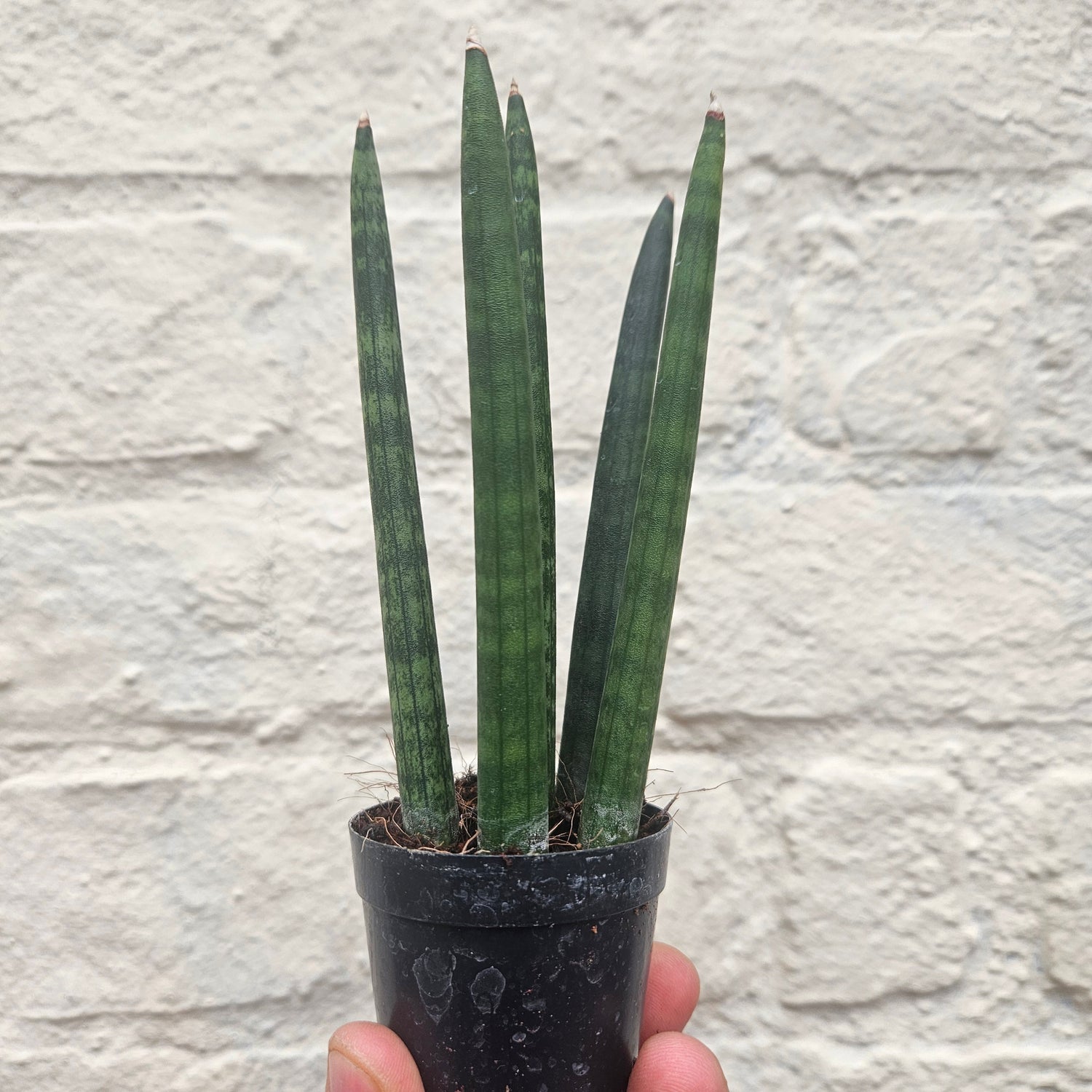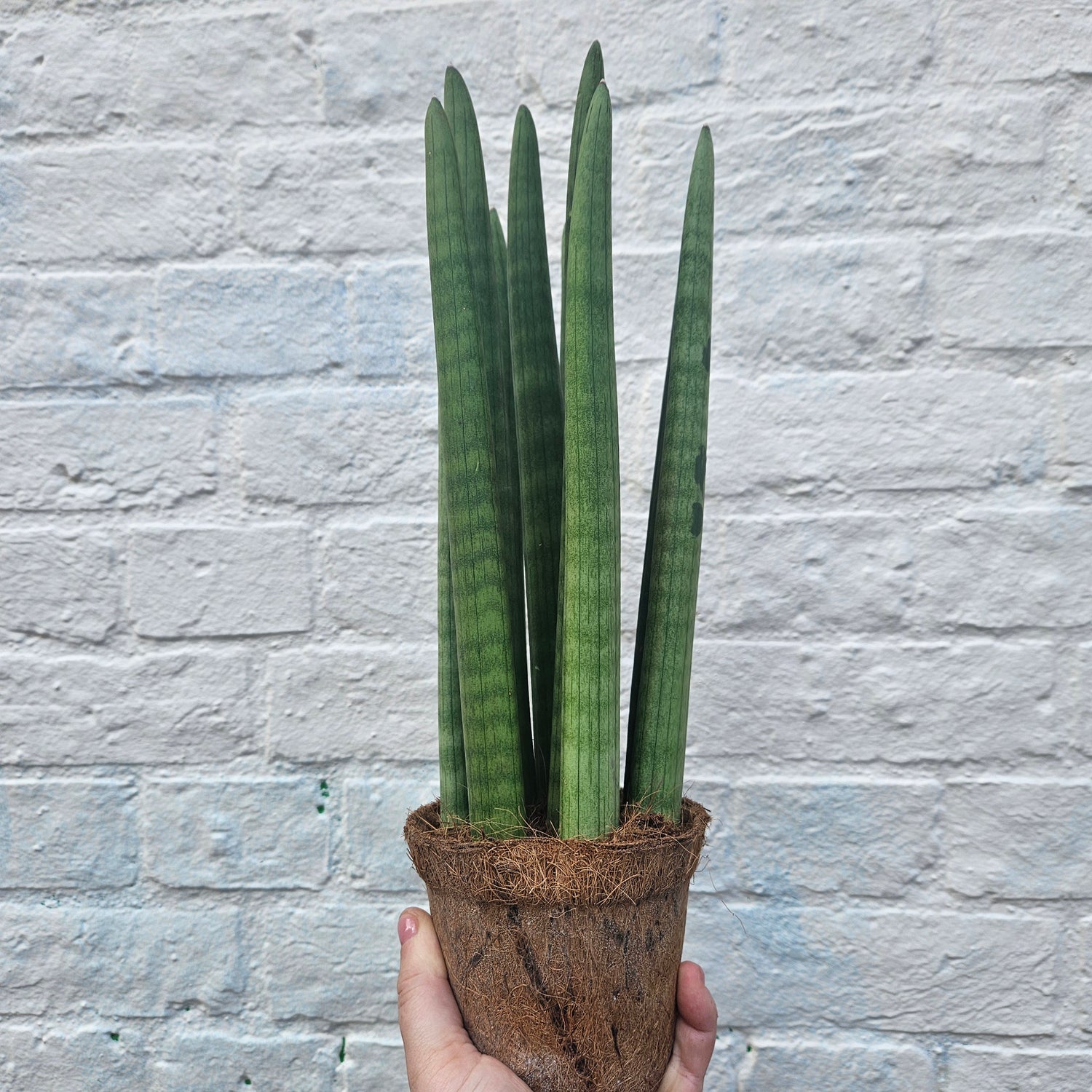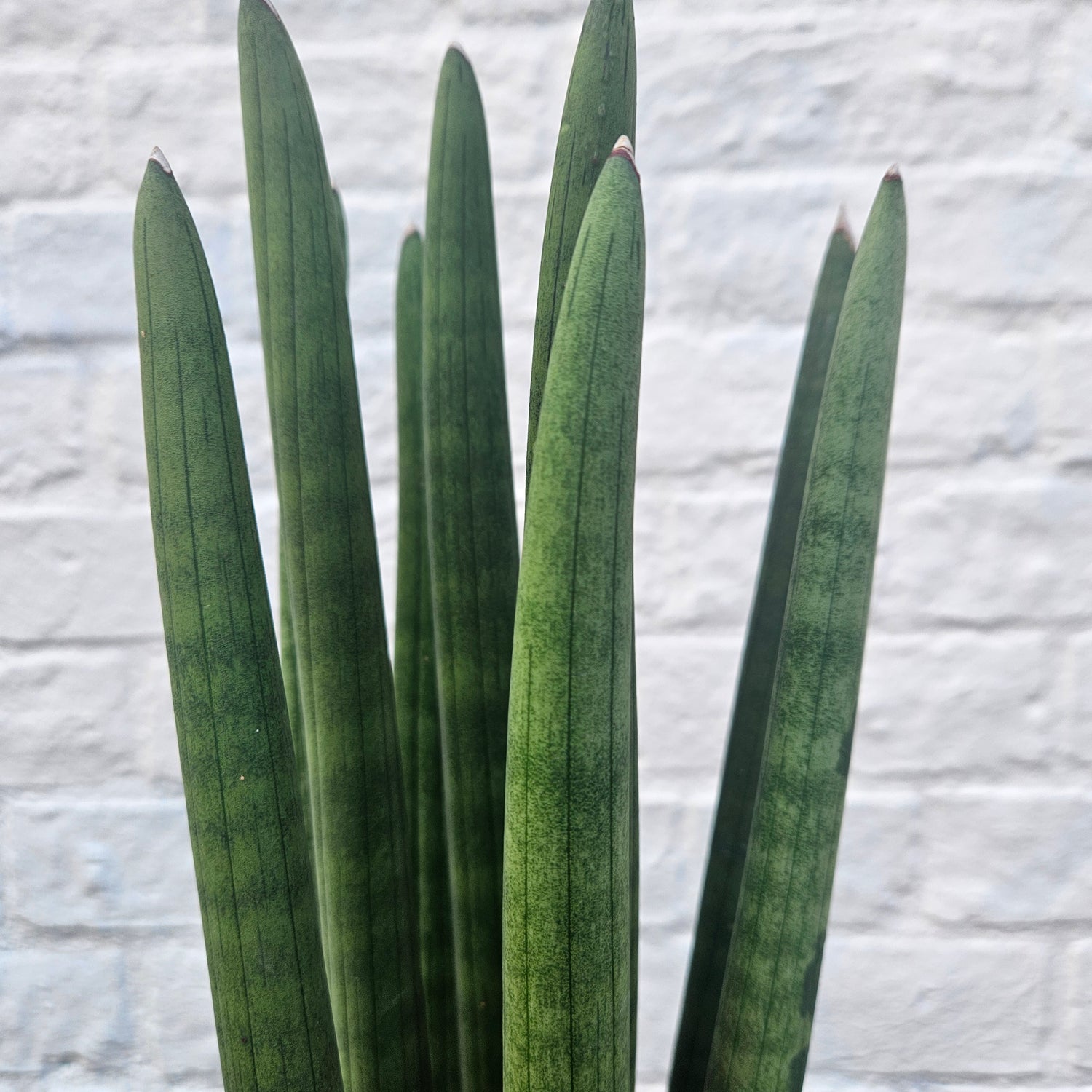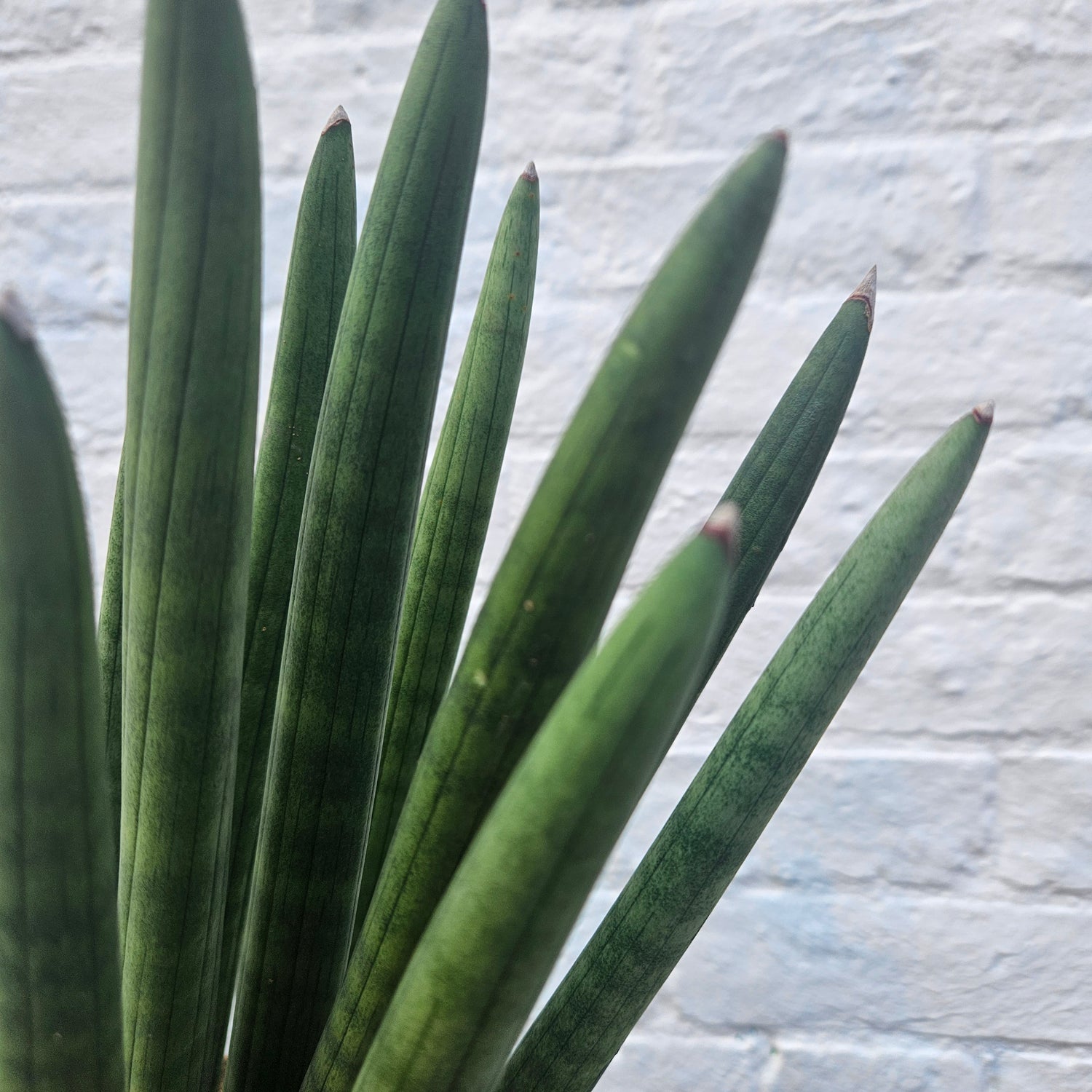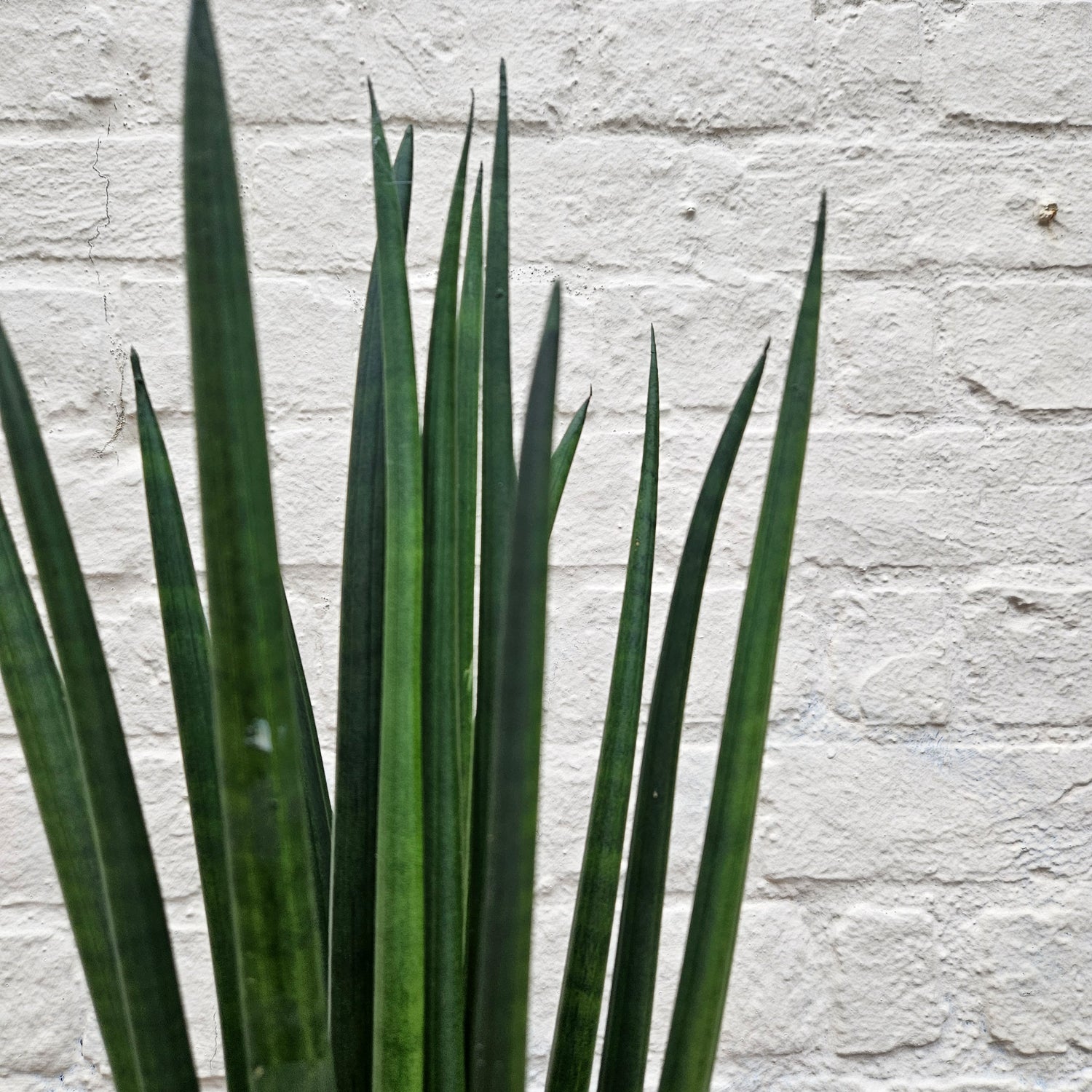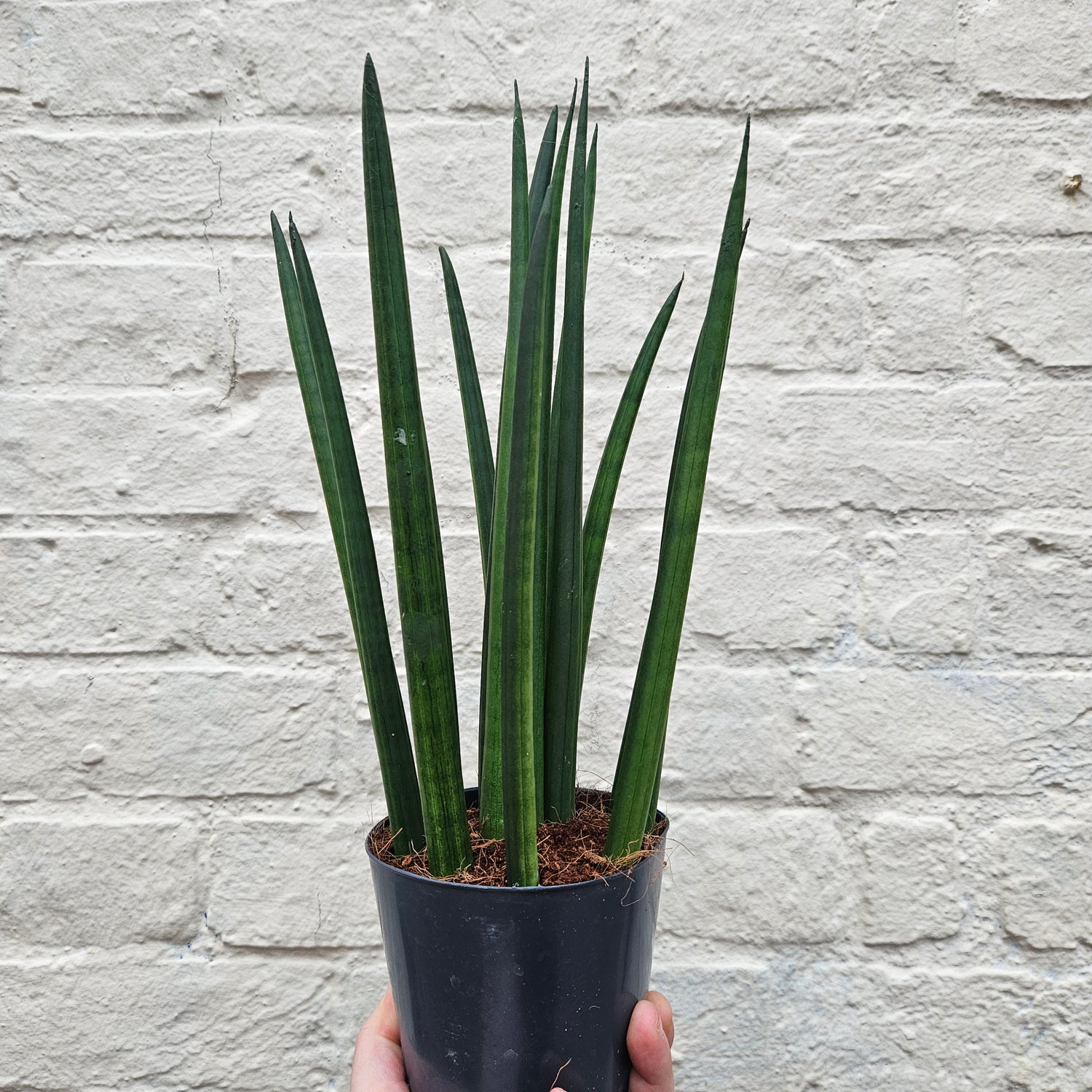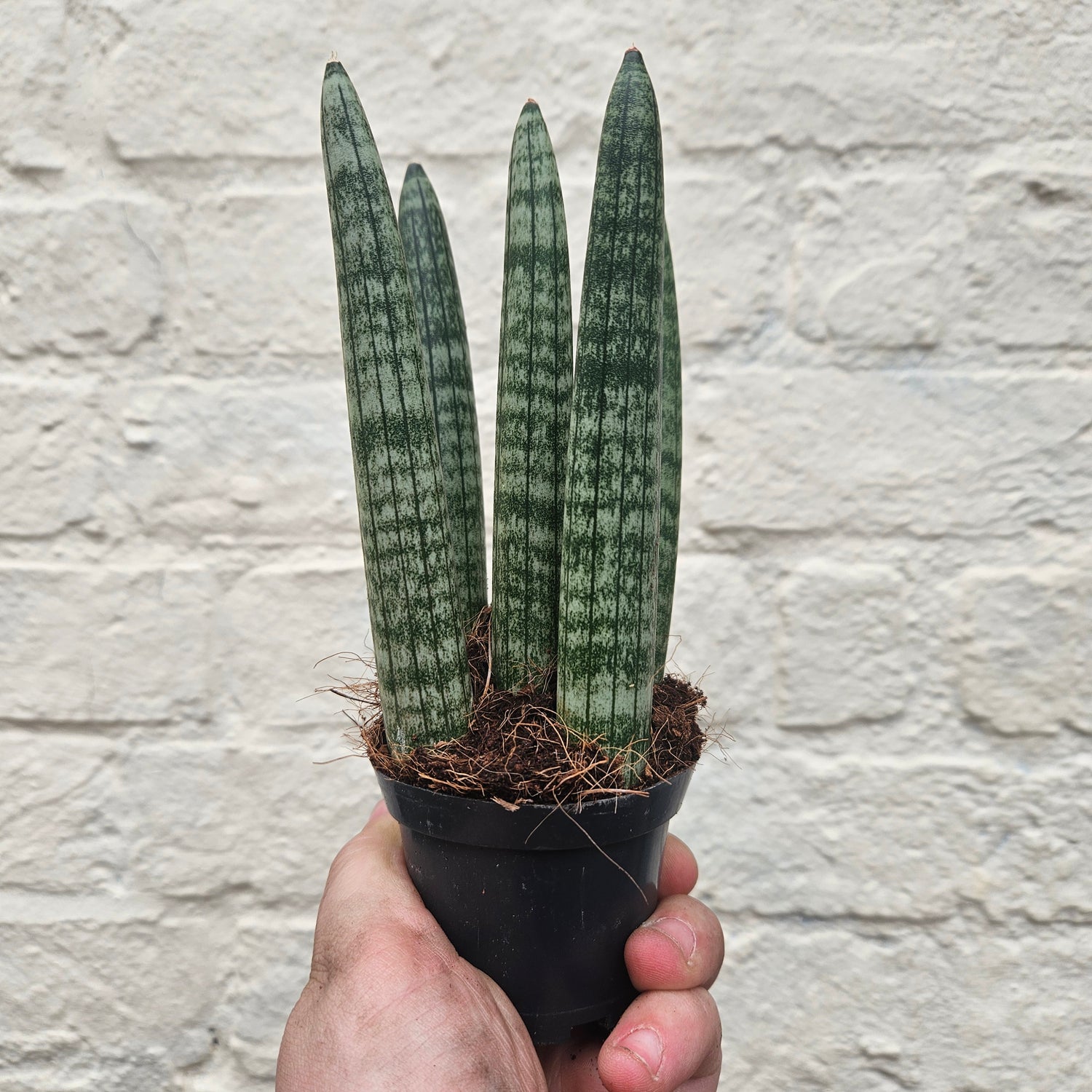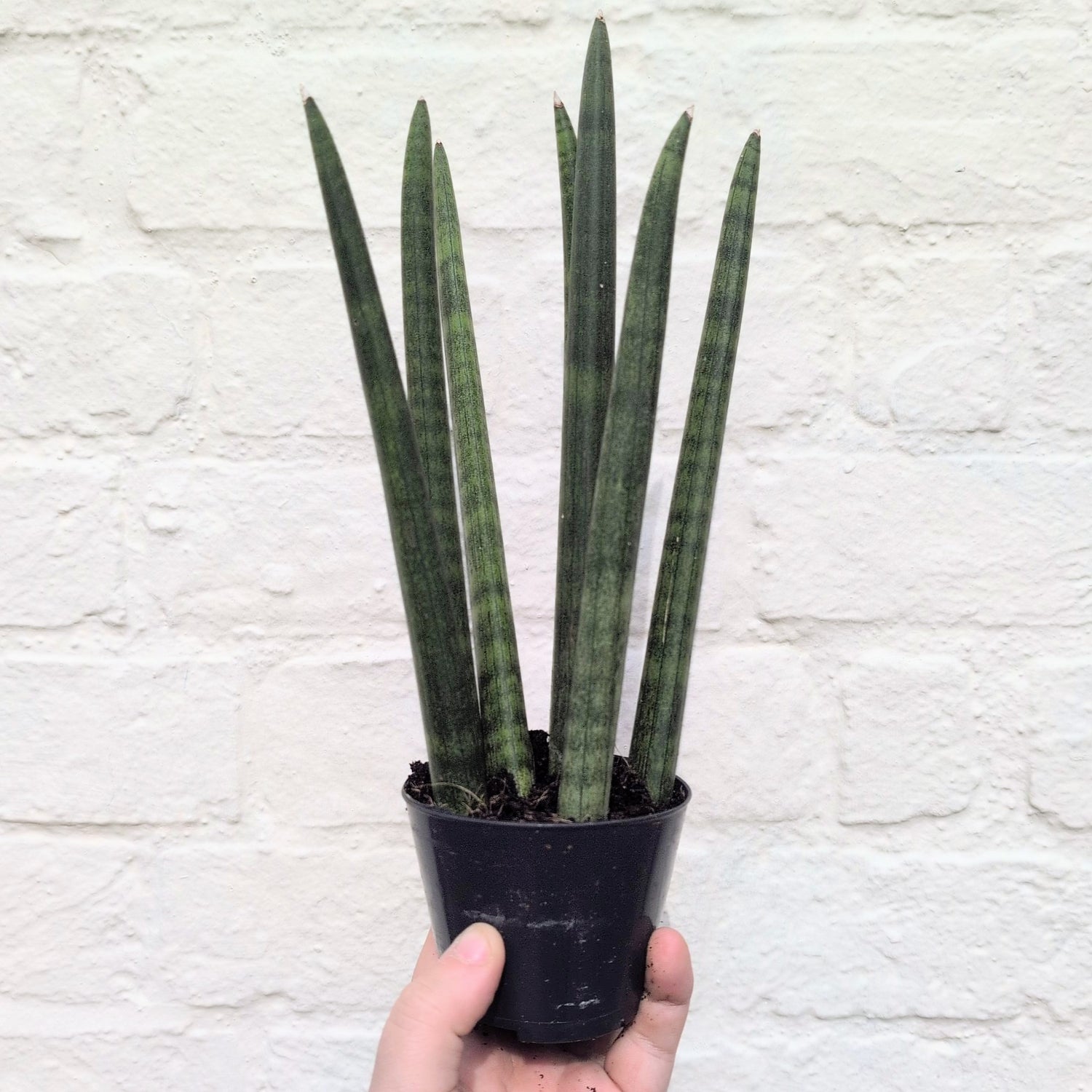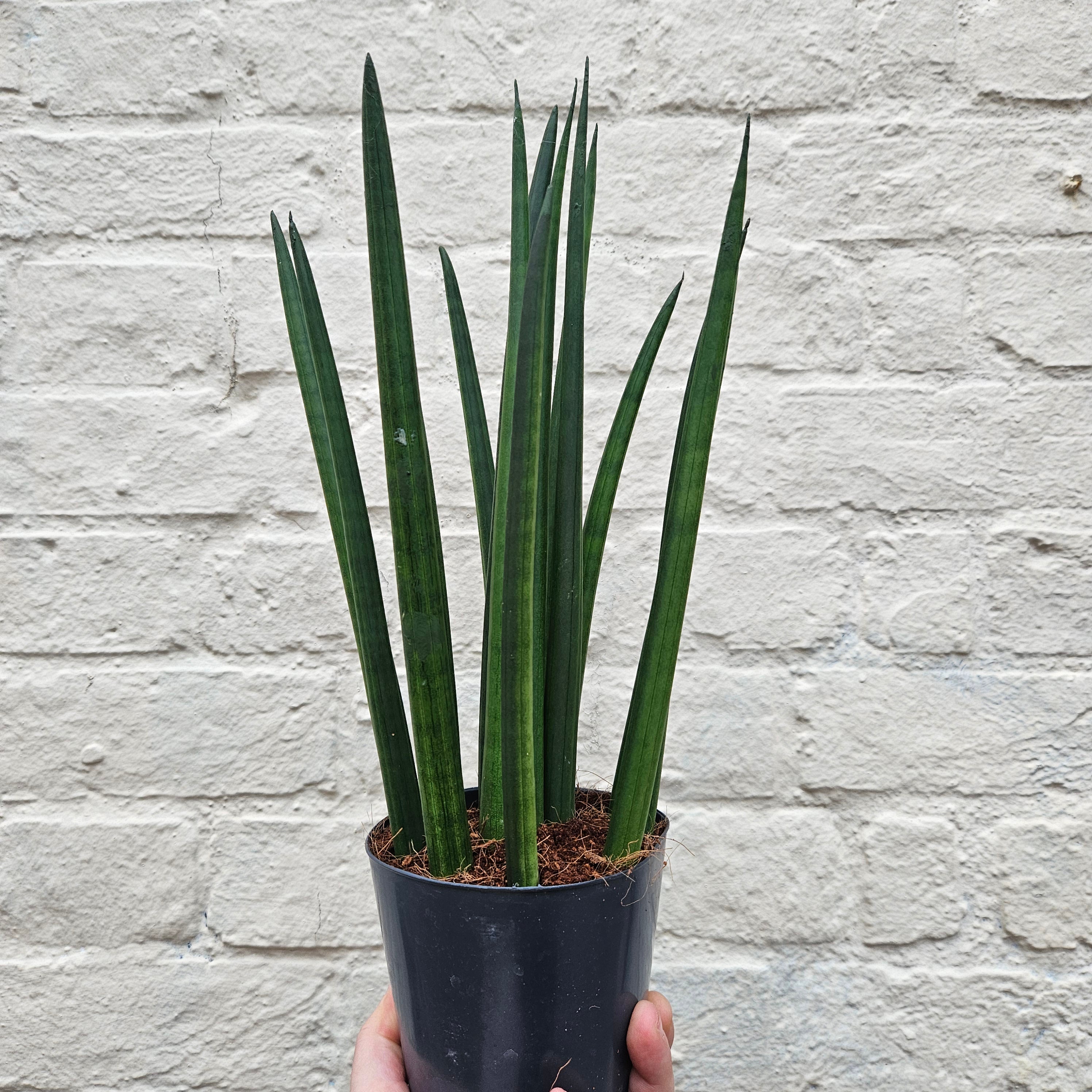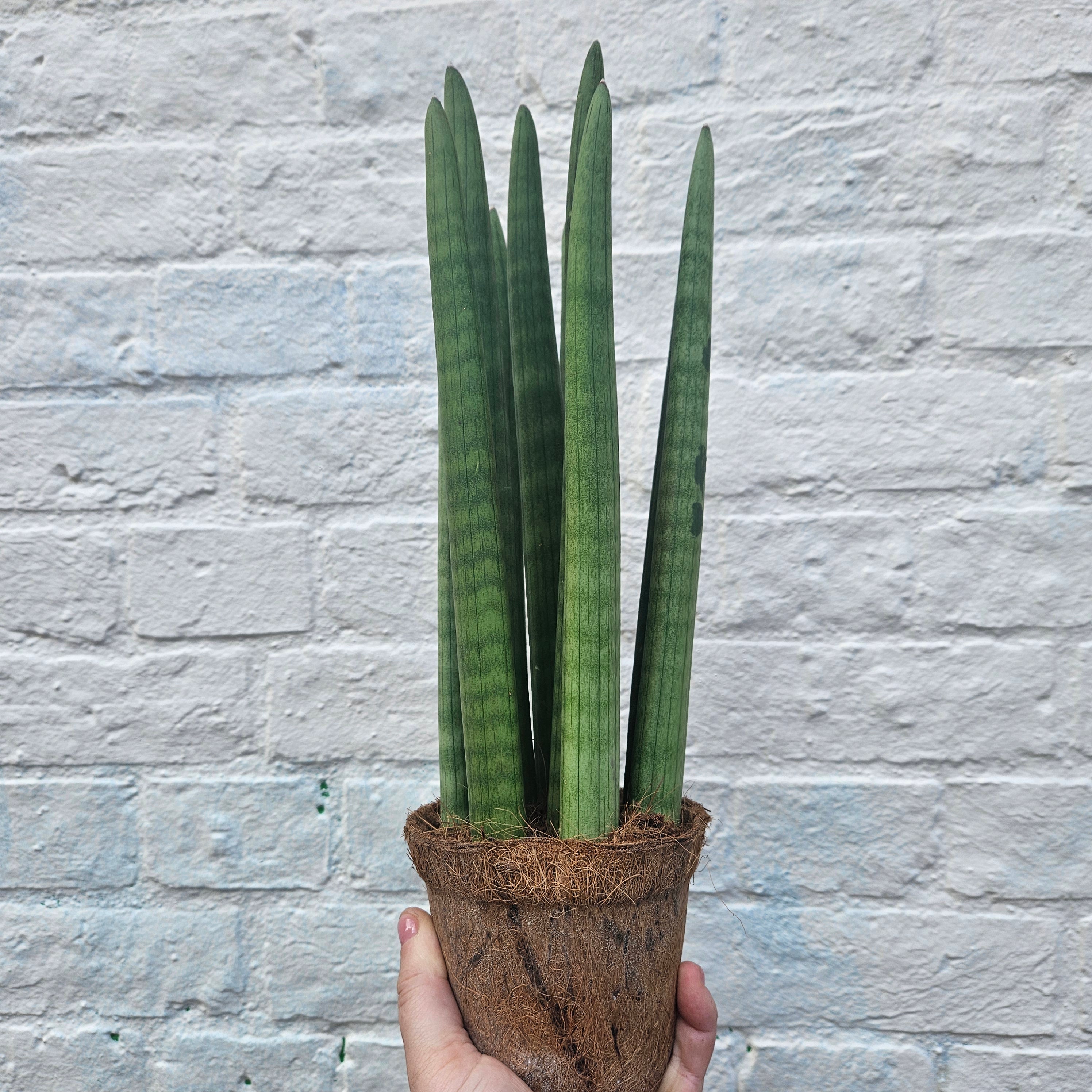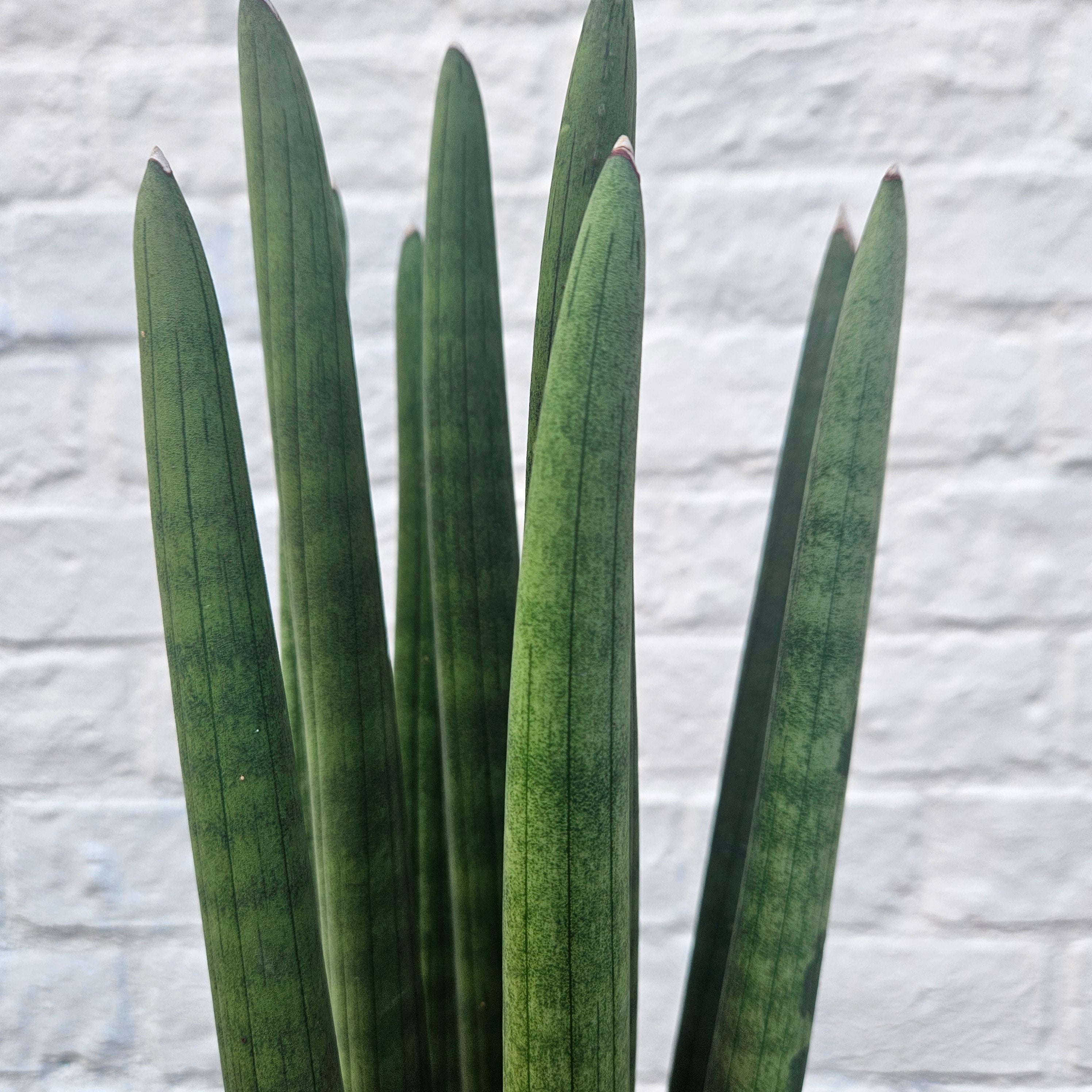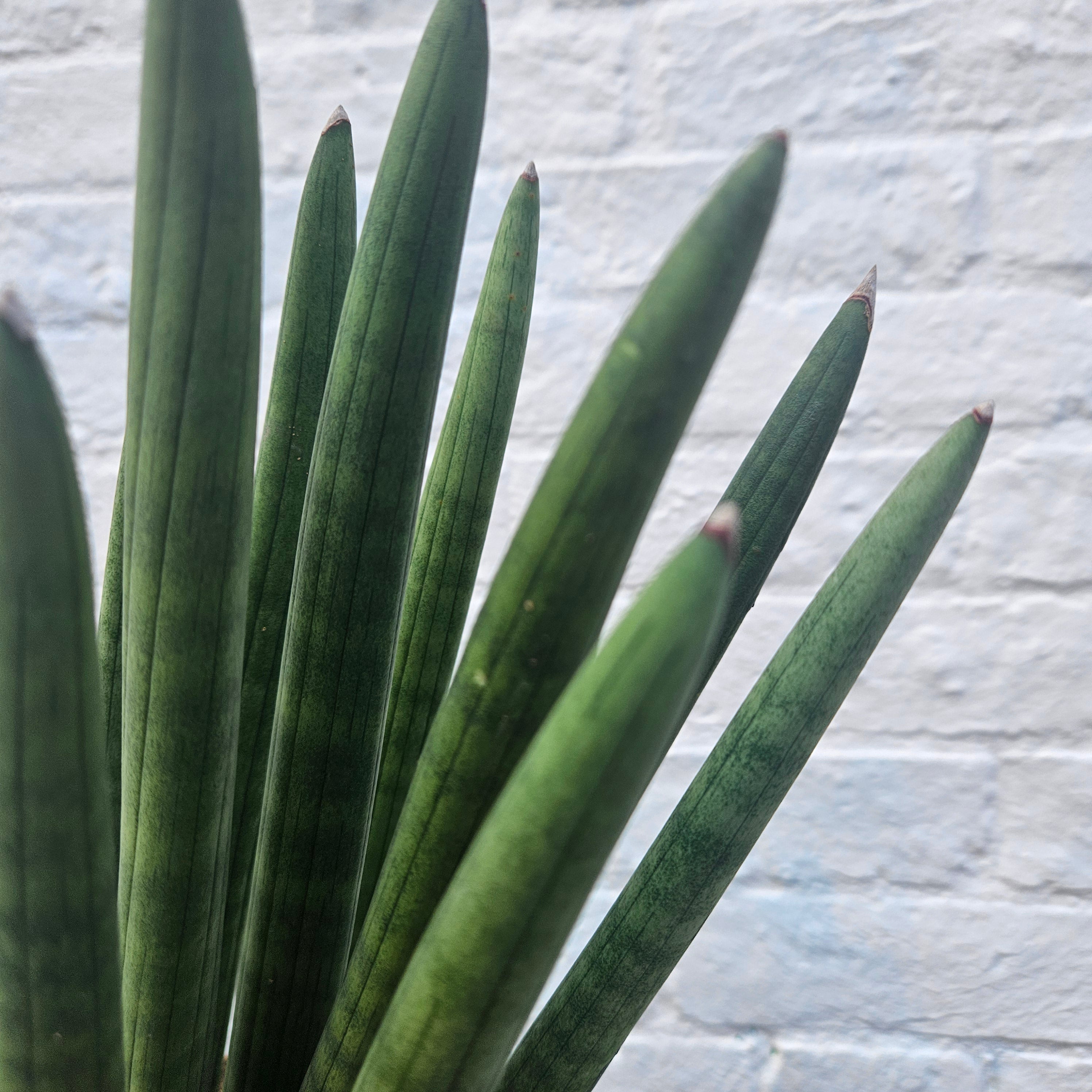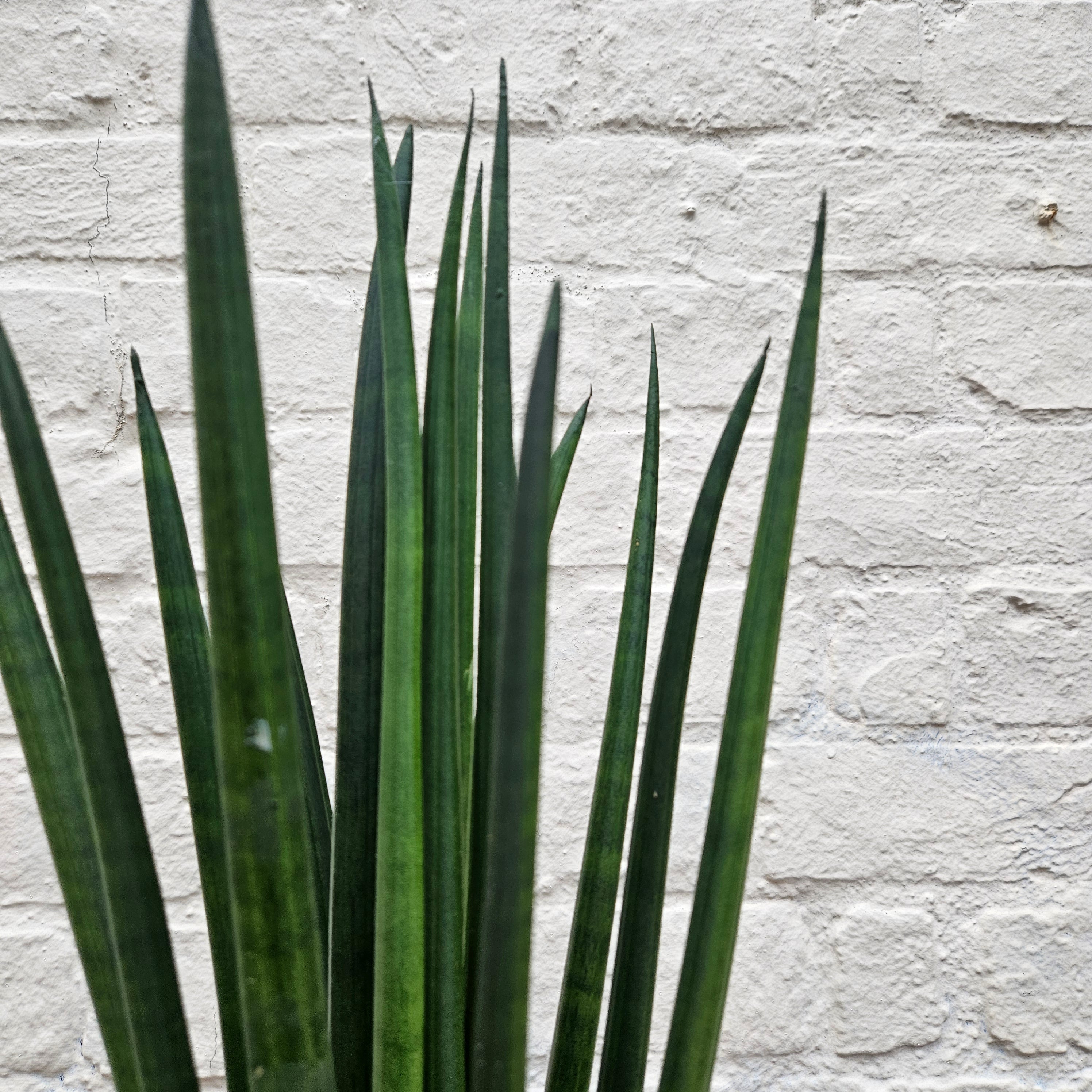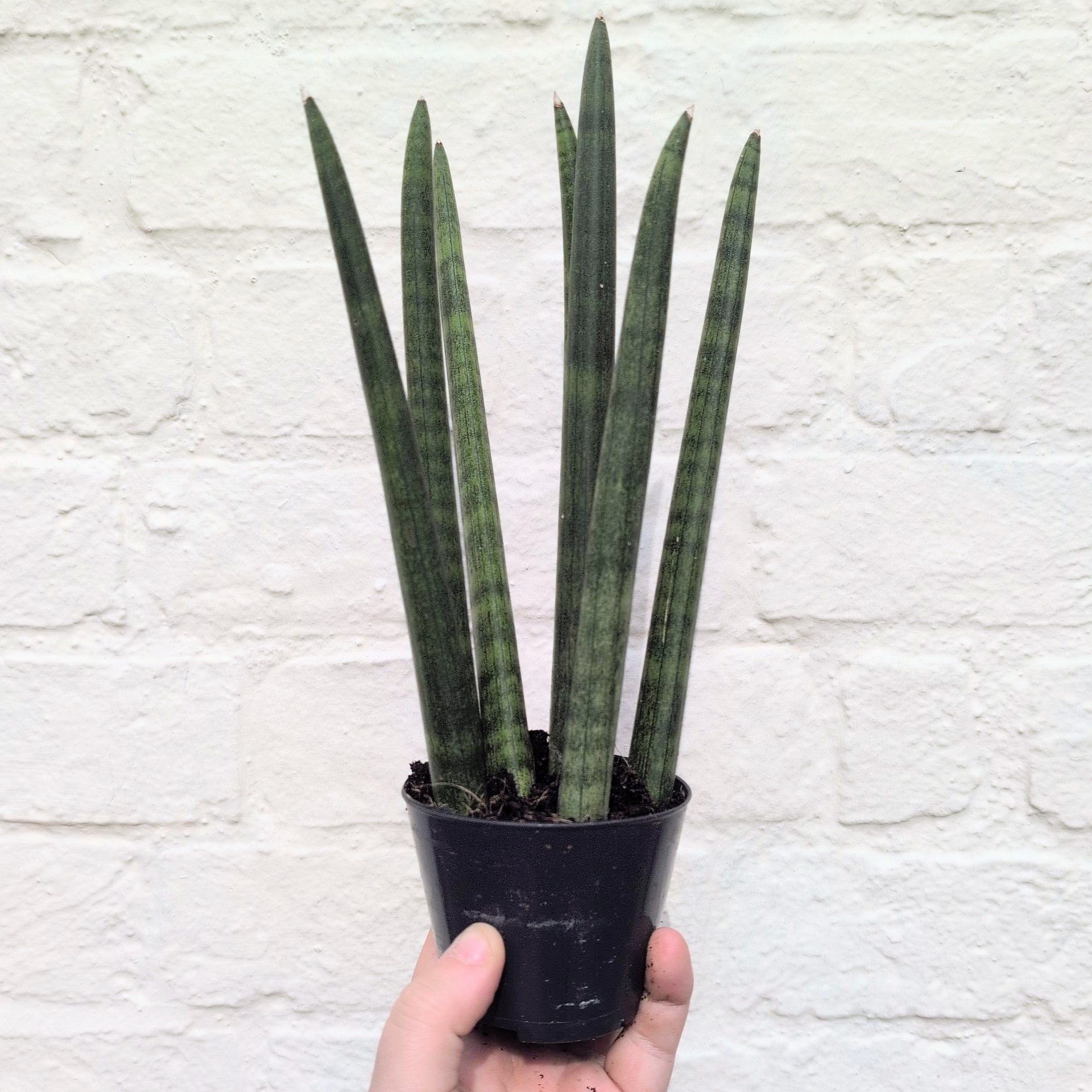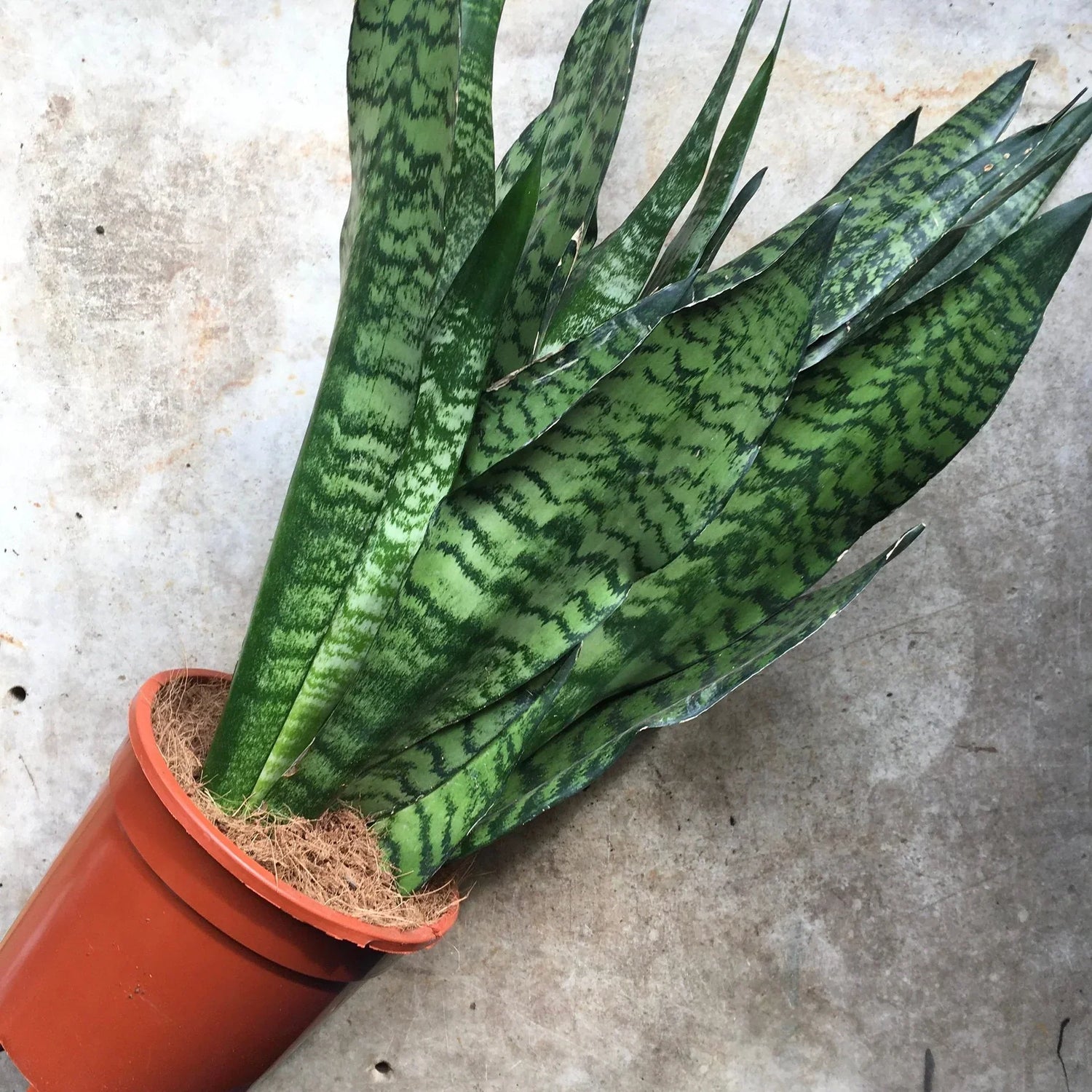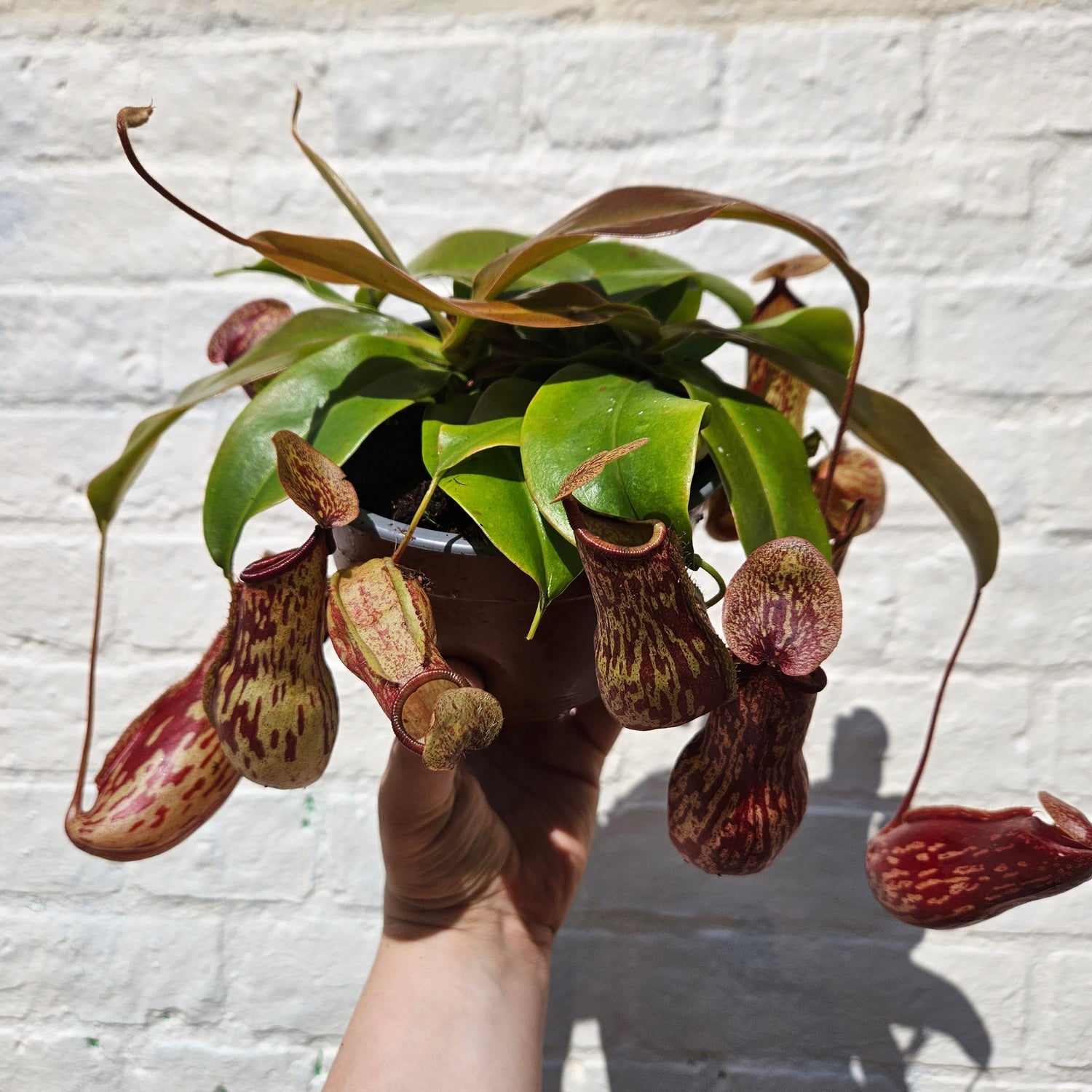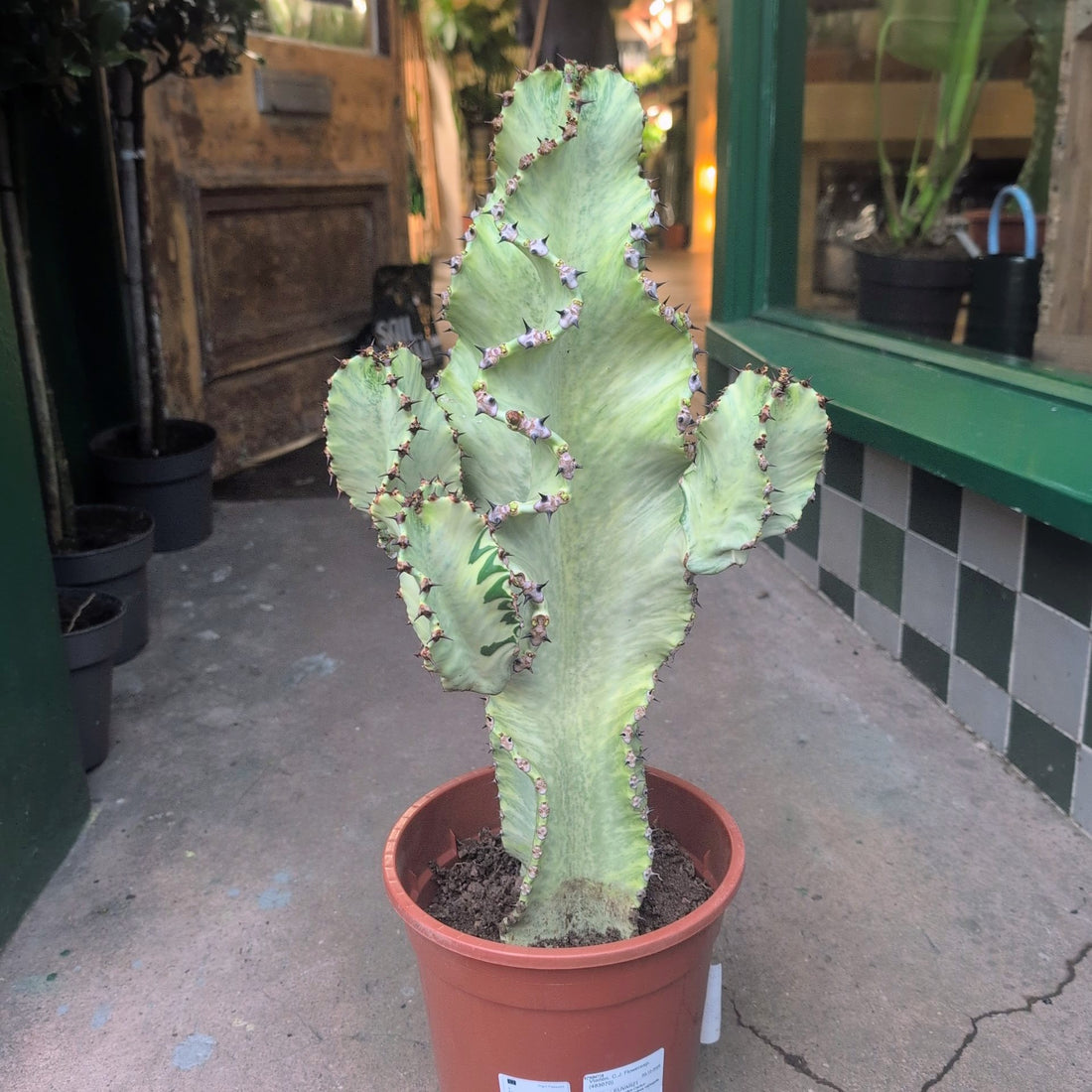One of the most popular and sought-after houseplants, Sansevierias are loved for their striking looks, easy care, and near indestructible nature. Incredibly drought-tolerant, they can go weeks without water and adapt to a wide range of light conditions, from low light to bright, indirect sun. Native to Western and Southern Africa, they’ve also become naturalised in places such as Florida and Hawaii. With so many varieties to choose from, each has its own unique charm, but the most distinctive and widely recognised are those with tall, sword-like leaves.
Sansevieria Overview
The Sansevieria, more commonly known as the Snake Plant or Mother-in-Law’s Tongue, is an incredibly diverse group of plants. Loved for their long, upright, architectural leaves that grow from a rosette base, they bring bold structure and elegance to any space. A perennial succulent in the Asparagaceae family (alongside agave), Sansevierias were recently reclassified by botanists into the Dracaena genus. Their thick, waxy leaves can reach up to 8 feet in the wild, though indoors they typically grow to around 3 feet. With countless species and cultivars available, there’s a wide variety of colours, patterns, shapes, and sizes to choose from—each with its own unique charm.
-
Sansevieria trifasciata ‘Moonshine’ – Tall, upright, sword-shaped leaves with a striking silvery-green to grey-green tone.
-
Sansevieria bacularis ‘Mikado’ – Elegant, cylindrical, spear-like leaves in deep green, marked with faint lighter green striping.
-
Sansevieria masoniana ‘Victoria’ – Known as the ‘Whale Fin’, this variety features a single broad, architectural leaf that makes a bold statement.
-
Sansevieria trifasciata ‘Laurentii’ – A classic variegated cultivar, easily recognised by its creamy-yellow leaf margins framing rich green centres.
Sansevierias use a clever adaptation called CAM photosynthesis. Their stomata—tiny pores on the leaves—stay closed during the day to conserve water and open at night to take in carbon dioxide, which they convert into oxygen. This process has led to their reputation as air-purifying plants and even sleep-boosters. While studies have shown Sansevierias can filter air in controlled lab settings, you’d need to fill an entire room with them to see the same results at home!
How to Look After a Sansevieria
Light:
Sansevierias are highly adaptable and will tolerate a wide range of light conditions, from low light to bright, indirect sunlight. For the best colour and growth, they prefer bright, indirect light, kept out of harsh midday sun which can scorch their leaves. They can cope with a little gentle direct light, such as early morning or late afternoon sun, but also do well in shadier corners of the home.
Temperature and Humidity:
Sansevierias thrive in temperatures between 15°C and 27°C, making them well-suited to most homes. As a hardy perennial succulent, they are perfectly happy in average household humidity and even tolerate drier air. No misting is required.
Watering:
When it comes to watering Sansevierias, less is more. These plants are naturally drought-tolerant and can easily cope with a missed watering or two. Always allow the soil to dry out completely before watering again. When you do water, soak the soil thoroughly until water drains from the bottom of the pot, then tip away any excess. In lower light conditions, your plant will need less water than one kept in brighter light. During the winter months, reduce watering even further — often to once a month or less. The most common cause of problems is overwatering, so it’s always safer to err on the dry side.
Fertilising:
Feed your Sansevieria every 4-6 weeks during the growing season (normally spring and summer). Use a balanced feed containing nitrogen, phosphorus and potassium. Always follow the instructions on the fertiliser packaging for proper application. We sell both liquid and slow release fertilisers suitable for your houseplants.
How to Repot a Sansevieria
Sansevierias only need repotting every 2–5 years, or when their roots become crowded, circling the pot, or pushing through the drainage holes. They don’t mind being slightly root-bound, so there’s no rush to repot. Signs that it’s time include the plant becoming top-heavy, the soil drying out too quickly, or growth slowing right down.
The best time to repot is in spring, as the plant enters its active growth phase. Gently remove it from its pot and move it into a container just one to two sizes larger. Always use a well-draining cactus and succulent mix to prevent waterlogging.
How to Propagate a Sansevieria
Propagating Sansevieria is an exciting way to grow new plants.
Division Propagation:
One way to propagate your Sansevieria is by dividing it during repotting. Gently remove the plant from its pot and brush away the soil to expose the roots. Identify natural divisions and, using a clean, sharp knife, cut between them, ensuring each section has at least one growth point. Plant the divisions in separate pots filled with fresh cactus and succulent potting mix and water lightly.
Water Propagation:
-
Choose a Healthy Stem: Select a mature stem
-
Cut the Stem: Use a clean, sharp knife or scissors to cut it. You can either propagate the whole leaf or cut it into segments that are 2-3 inches long. (Ensure your remember the top and bottom of each piece)
-
Rooting: Place the cutting in water, making sure only the bottom inch is in water. Roots should develop within a few weeks.
-
Changing water: Make sure to refresh with new water every couple of days to a week.
-
Transplant: Once your cutting has well-established roots, transplant it into a pot with the appropriate soil mix.
Soil Propagation:
-
Choose a Healthy Stem: Select a mature stem
-
Cut the Stem: Use a clean, sharp knife or scissors to cut it. You can either propagate the whole leaf or cut it into segments that are 2-3 inches long. (Ensure your remember the top and bottom of each piece)
-
Drying out: Allow the ends to callus over.
-
Plant: Dip the bottom end into rooting hormone and plant into cactus and succulent potting mix about an inch deep.
-
Care: Place in bright indirect light and keep soil moist. It can take a few weeks to months for roots to grow and new shoots to emerge.
How Often Should I Water a Sansevieria
Watering frequency depends on various factors like temperature and pot size. As a general rule, water when the soil is completely dry. Water less in winter and more frequently during the growing season.
Why Are My Sansevieria Leaves Going Yellow/Brown/Drooping?
-
Yellow Leaves: Yellowing leaves are usually a sign of overwatering or poor drainage. Only water when the soil is completely dry, and if necessary, repot into a well-draining cactus and succulent mix.
-
Brown Leaves: Brown edges or spots can result from low humidity, under watering, or too much direct sunlight. Increase humidity if your space is very dry, and adjust your watering routine—water only when the soil has fully dried. In warmer months, this may mean watering more often. Make sure your sansevieria isn't getting any midday direct sunlight.
-
Drooping Leaves: Drooping or wilting leaves are typically caused by overwatering (which can lead to root rot) or severe under watering. Ensure you only water once the soil is dry. While Sansevierias tolerate occasional missed waterings, frequent over- or under-watering can stress the plant.
Are Sansevieria Poisonous to Cats and Dogs?
Yes, Sansevieria are toxic to humans and pets if ingested due to the presence of saponins, which can cause vomiting, nausea and diarrhoea. Keep them out of reach of children and pets to prevent accidental consumption. If ingested, seek medical attention immediately.
These expert tips should enable you to care for your Sansevieria and enjoy its striking foliage. Happy Snake plant growing!
